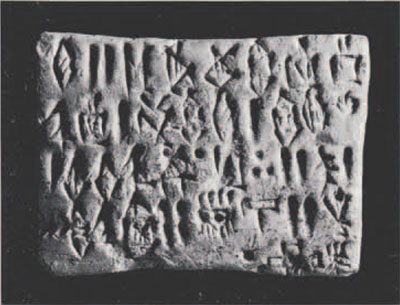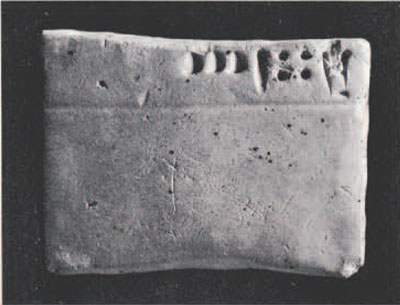Among the objects recently acquired by the Museum in its exchange with the Musee du Louvre is the Proto-Elamite account tablet shown above, the first of its kind in the Museum’s collections. The tablet is of particular interest because the script of the text and of others like it has yet to be deciphered.
The known Proto-Elamite documents fall quite clearly into two groups. One group includes a very limited number of “monumental” inscriptions of which no more than sixteen examples are known; the second and by far the larger group, of which the tablet above is representative, is made up of economic or accounting texts and is by several centuries the older of the two groups. These accounting documents are known from Susa, in phase Cb, where over 1400 tablets and fragments have been found in successive campaigns; from Tepe Sialk, near Kashan between Teheran and Isfahan, where a handful of texts, mostly fragmentary, was discovered; and from Tall-i-Ghazir to the southeast of Susa near Ram Hormuz. The economic texts have been dated, largely on the strength of the seal impressions which some of them bear, to the period 2900-2600 B.C. In certain respects the script of the early group of Proto-Elamite texts shows resemblances to the archaic Sumerian writing employed in Mesopotamia at about the same time during the Jemdet Nasr period, leading some scholars to postulate the development of the Proto-Elamite writing system under Mesopotamian influence.
However this may be, and despite a recently proposed interpretation of the later, “monumental” inscriptions, the economic texts remain undeciphered. This is due primarily to the fact that they are probably written using only number signs and logograms (often called ideograms). Logograms are not phonetic, but rather represent entire words; thus, although it is occasionally (though rarely) possible to identify the objects symbolized by a representational logogram (a horse, a plough), no idea at all can be gained of the language itself. Only the use in the accounts of a decimal system of numeration has been demonstrated with fair certainty. It has also been shown that the texts should be read from right to left across their greater dimension, and from top to bottom. The basic repertory used in writing the Proto-Elamite texts probably contained over one hundred but not more than two hundred signs, although one compilation which includes all variant forms lists some 5,529 signs.
That the documents have to do with accounts is deduced from their orderly and internally consistent entries of numbers, often along with their sums, in association with signs representing the items enumerated. The whole system is so cohesive and well developed that it bespeaks a complex and active economic organization whose records may have been the work of the personnel administering it.
Our new Proto-Elamite tablet has been assigned accession number 68-1-1. It was excavated at Susa, apparently in 1901, by J. de Morgan and has been published by the French Mission in Iran as Text No. 214. It is also briefly mentioned in an excellent recent article by William C. Brice, “The writing system of the Proto-Elamite account tablets of Susa,” in Bulletin of the John Rylands Library, Manchester XLV, No. 1 (September 1962):15-39. The reference to the tablet discussed here is on p. 31. Brice suggests that the Proto-Elamite account texts “appear to be some kind of statistical or mercantile records.”
We are especially pleased to have added to the collections of the University Museum an example of one of the outstanding conundrums still exercising students on the ancient Near East.


